Authentic Enchilada Sauce
This post may contain affiliate links. See my disclosure policy.
Rich and robust and a thousand times better than store-bought, this homemade authentic enchilada sauce recipe packs some serious FLAVOR! Not just for enchiladas, this sauce will take your soups and stews to a whole new level!
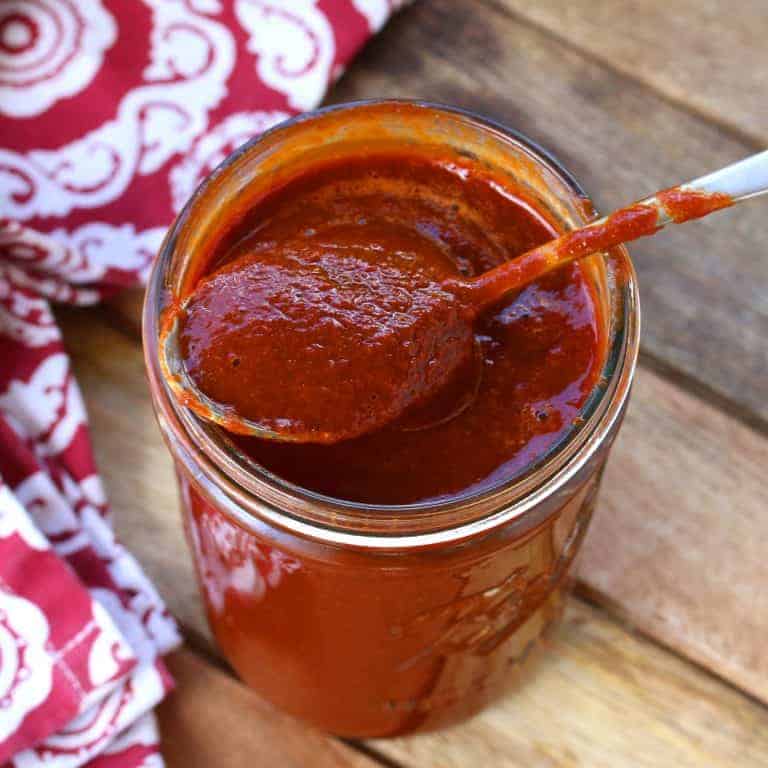
Nothing beats homemade. That’s a phrase that fits most everything when it comes to cooking. And it’s most definitely fitting of homemade enchilada sauce. Rich and robust and at least a thousand times better than store-bought, this authentic enchilada sauce recipe (red chile sauce) packs some serious FLAVOR! It’s very easy to make, you just need the right ingredients. Above all, you need quality chiles (more on that later). And for a truly fantastic, authentic enchilada sauce it’s also vital that you follow a few important rules (see below).
How to Make Authentic Enchilada Sauce
For an authentic enchilada sauce there are some important steps you need to take and several ingredients you need to use and avoid:
- Use dried whole peppers, not ground chili powder. Using whole dried peppers, roasting them, then reconstituting and pureeing them will give you a much richer, more complex, more flavorful sauce with flavor notes you won’t get from chili powder. There really is no comparison. And adding a dash of smoked paprika won’t compensate for not using dried whole chilies and roasting them.
- Toast the dried peppers. This really enhances the flavor.
- Don’t scorch the dried peppers. If you scorch the peels while toasting them you’ll end up with a very bitter sauce. In the even that that happens, add some additional onion and a dash of sugar to take the edge off the bitterness.
- Use fresh garlic, not garlic powder. Roast it along with the peppers for optimal flavor.
- Use fresh onion, not onion powder. Roast it along with the peppers for optimal flavor.
- Say NO to flour. That’s used in some red chile sauce recipes to compensate for not using whole dried chilies. The whole chilies, once reconstituted and pureed will be the natural thickener for your sauce. Keep the flour for your tortillas, not your enchilada sauce.
- Cook the sauce. After pureeing and straining the sauce, cook it. As flavorful as the sauce already is, don’t skip this step, it is vital for bringing out the FULL depth of flavor of the sauce.
Before it’s cooked you’ve got a bright red and flavorful raw chile paste (see below), but after it’s cooked the color darkens to a brownish red and the flavors deepen. Oh, how they deepen!
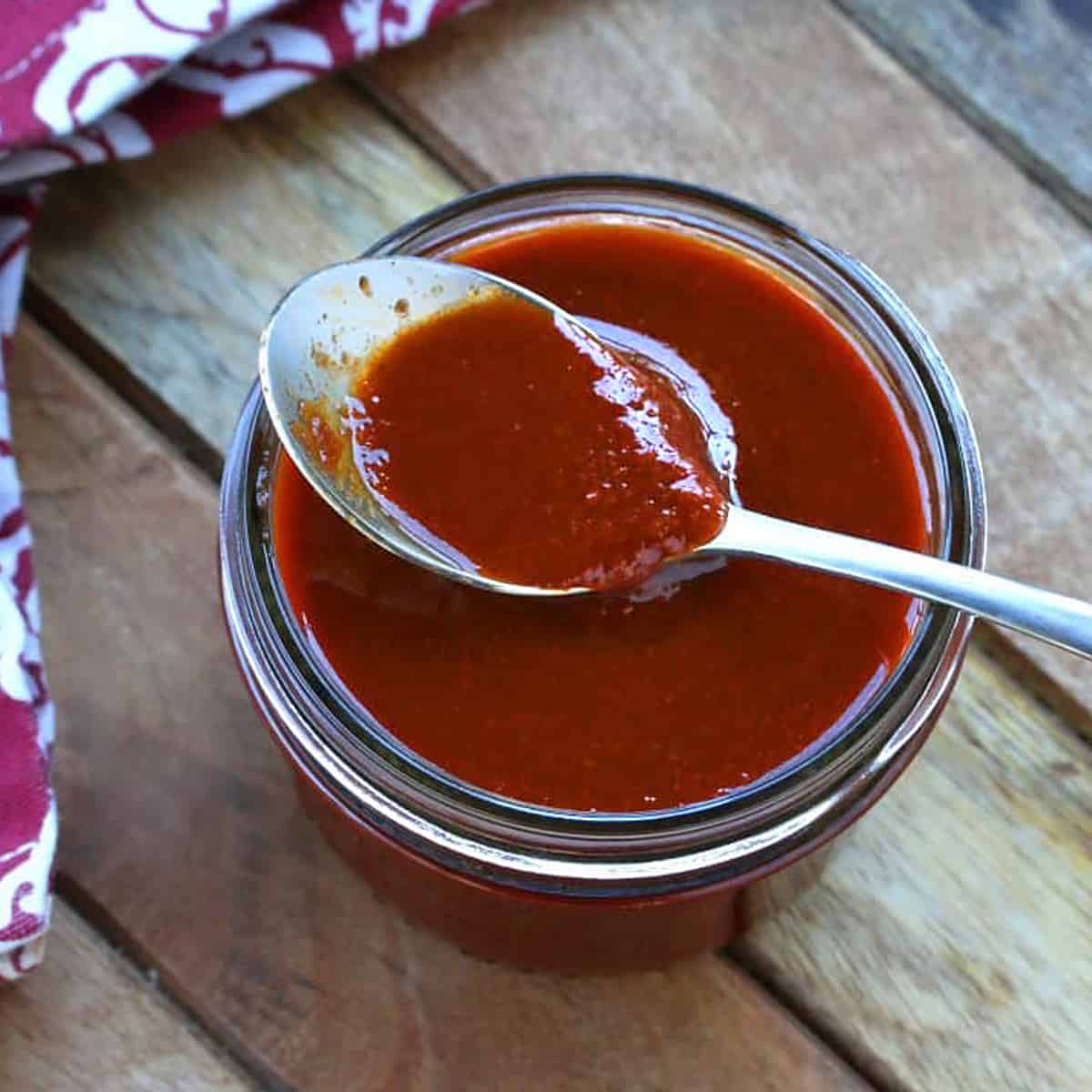
The Best Chili Peppers for Enchilada Sauce
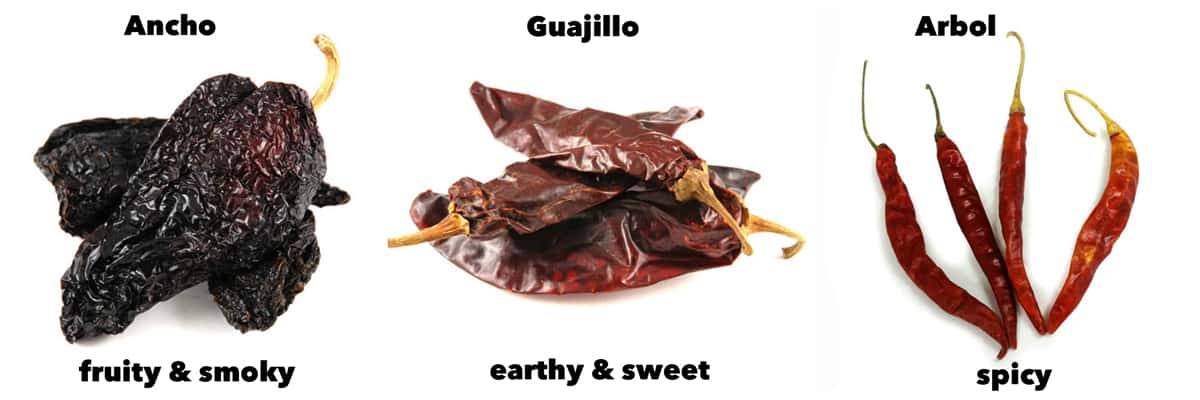
Which variety to use largely comes down to personal preference. You can choose one kind or a combination of peppers, which is what I like to do. Here are a few of my favorites with links to the brands I personally use and recommend:
Guajillo: Bright red, sweet with a touch of acidity with mild to medium heat. It’s one of the most commonly used chilies in Mexican cuisine with an earthy-sweet flavor and are great for adding body to stews, sauces and adobos.
Ancho: Very mildly spicy with a rich fruity and lightly smoky flavor. They contribute a beautiful dark red color to sauces. Ancho chilies are poblano chilies that have been allowed to fully ripen to a deep red and then dried. Also one of the most commonly used dried peppers.
Pasilla: Sweet, fruity flavor with medium heat. The name “pasilla” comes from the word pasas, meaning “raisins”, because of its deep fruity flavor.
Arbol: Earthy flavor and very spicy. While these don’t have a ton of flavor, they are your friends if you want to kick the heat up several more notches.
A critical key to making the best enchilada sauce is to select the best quality dried chilies you can find. Most dried chiles I come across in grocery stores and online are poor quality. They’re old and brittle and flavorless.
How to Choose “Fresh” Dried Chiles
- They should be pliable and flexible (think a stiff version of fruit leather), not overly dry or brittle.
- Their skins should be glossy, not dull.
- They should have a good smell, a little like dried fruit, not a dusty smell.
Authentic Enchilada Sauce Recipe
Let’s get started!
Start with that all important step: Roasting! Heat a heavy non-stick skillet (I like to use cast iron) over medium-high heat. Don’t add any oil. Lay the dried peppers on the skillet and toast them for a minute or two on each, just until they become very fragrant. It’s better to under-toast than to over-toast them as they will become very bitter if scorched. Remove and set aside. Next place the onion, garlic and tomatoes on the skillet and toast until lightly browned.
Note: Adding tomatoes is optional but I recommend it for curbing the sharpness of the peppers, balancing out the flavors and adding a touch of sweetness.
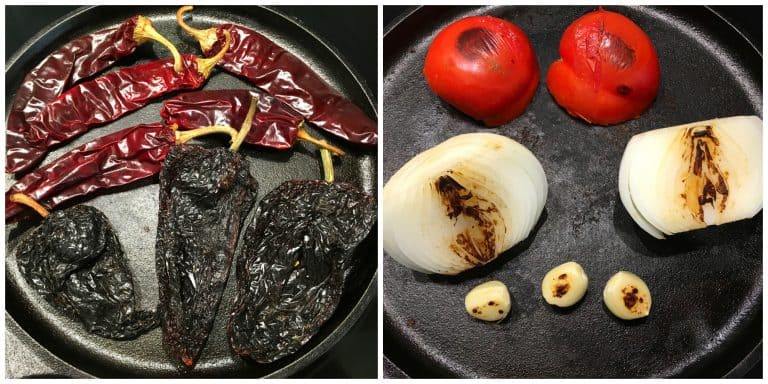
Remove the stems from the peppers (using gloves if you’re using hot peppers), slice the peppers open and remove and discard all of the seeds and the membranes (contrary to popular belief, it’s the membranes not the seeds that are hot, the seeds are bitter). Place the peppers in a bowl.
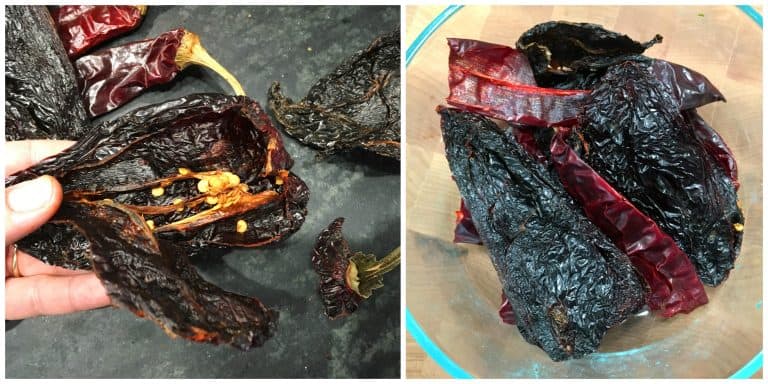
Pour the boiling water or chicken broth over the peppers, cover the bowl and let them sit for 20-30 minutes until soft.
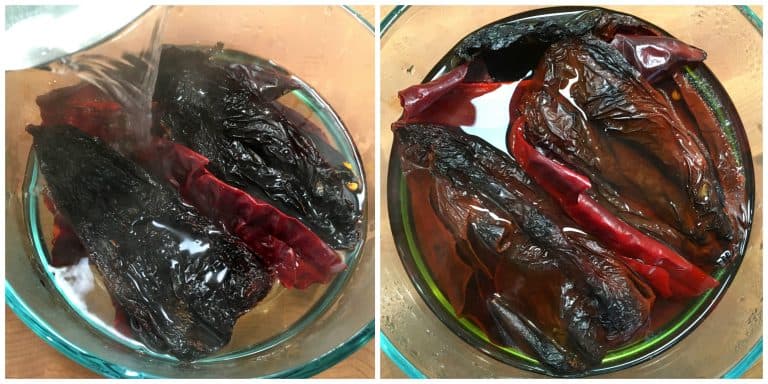
Place the peppers and their liquid along with the onion, tomato, garlic and all remaining ingredients (except for the chocolate if using) in a blender and blend until completely smooth.
At this point determine for yourself whether your sauce needs to be strained. I use a Vitamix which does an excellent job of blending the sauce to a very smooth puree, so I don’t bother straining it.
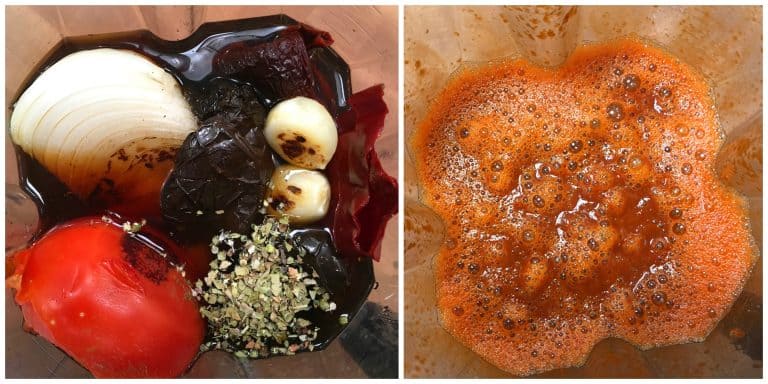
Heat a tablespoon or so of oil to a pot then add red sauce. Simmer it uncovered for about 30 minutes. Add a little more water if you prefer it thinner. The sauce should be the thickness of heavy cream.
For an added flavor touch, add in a small piece of semi-sweet chocolate at the end and stir until melted.
If the sauce is very bitter, add a touch of brown sugar.
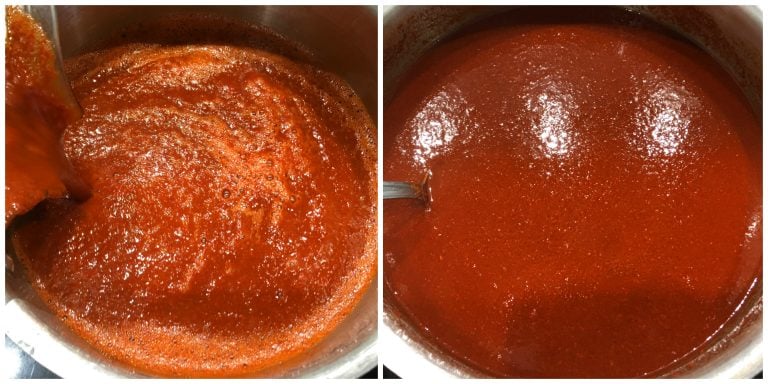
Store it in the fridge for up to a couple of weeks or freeze it. This sauce freezes well, so feel free to make extra so you have it on hand when you need it. I like to freeze it in ziplock bags, about one cup per bag so I can conveniently grab a bag whenever I need it.
For some more wildly delicious DIY Mexican recipes be sure to also try my Adobo Sauce, homemade Chipotle Peppers in Adobo Sauce, and from-scratch Chili Powder!
Ways to Use Enchilada Sauce
This authentic enchilada sauce recipe is a terrific “base” that you can add to any number of dishes for a wonderful flavor boost. Here are just a few ideas:
- Enchiladas (that one’s obvious!) and Tamales
- Soups and Stews: Add some to your favorite chili, pozole rojo, albondigas soup, creamy chicken tortilla soup, south of the border soup, etc.
- Tacos and Burritos: Add some to the shredded meat for even more flavor (e.g., tinga poblana tacos)
- Nachos: Add a scoop or two to your ground beef or shredded chicken.
- Refried Beans: Stirred in for a great flavor boost. Or add some to your queso fundido.
- Huevos Rancheros, Chile Rellenos, Chilaquiles: And anything else that could use a flavor boost!
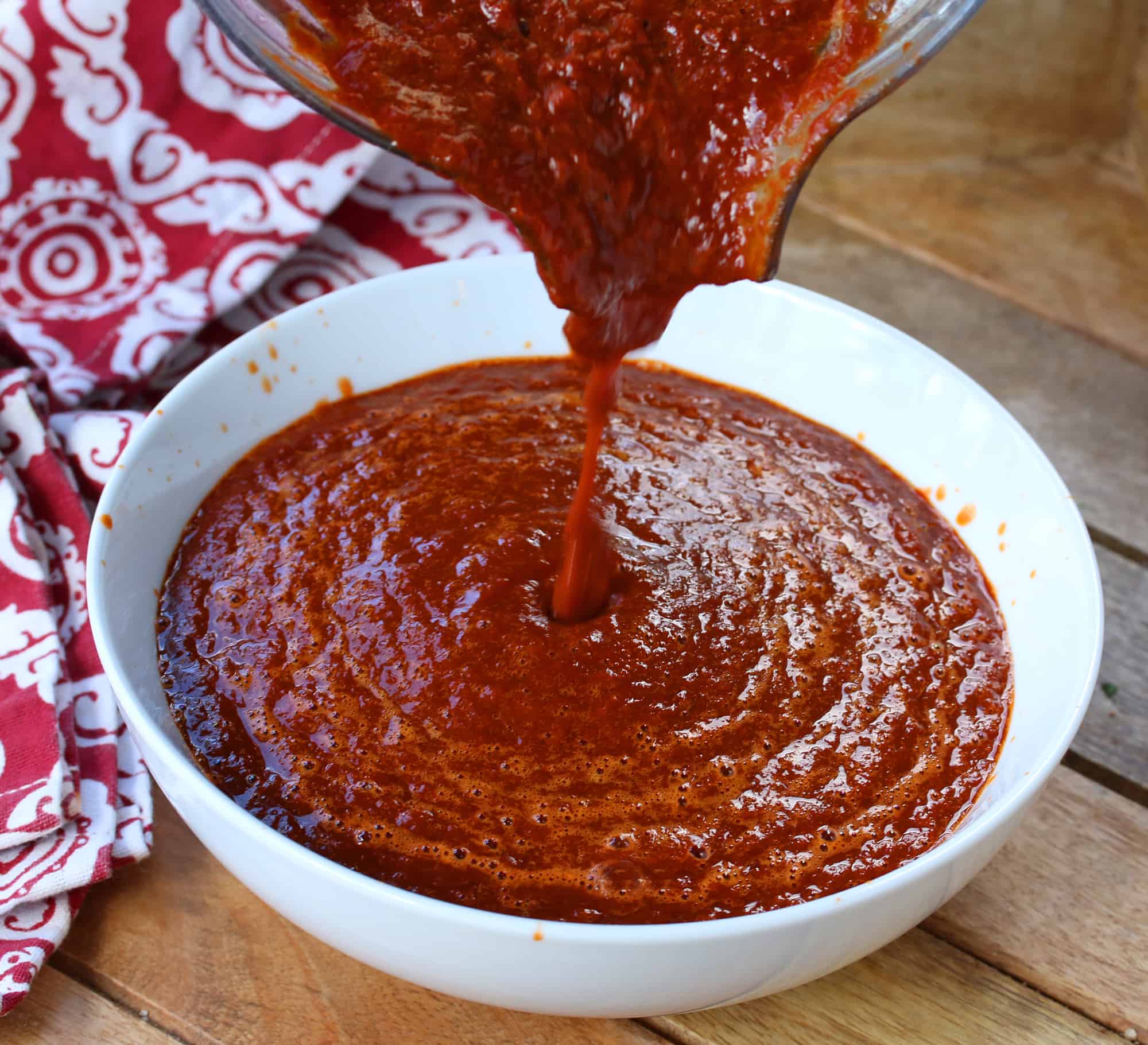
For more homemade sauces from around the world to try my:
- Adobo Sauce
- Teriyaki Sauce
- Hollandaise Sauce
- Sweet and Sour Sauce
- Bearnaise Sauce
- Romesco Sauce
- Mignonette Sauce
- Aji Verde
- Sriracha Mayo
- Black Bean Sauce
- Hoisin Sauce
- Chinese Plum Sauce
- Tartar Sauce
- Remoulade
- Kecap Manis
- Sweet Chili Sauce
- Yum Yum Sauce
- Harissa
- Homemade Ketchup
Save This Recipe
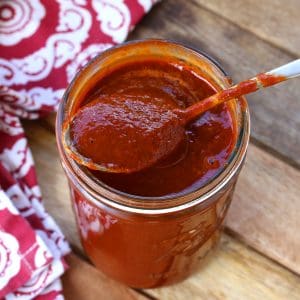
Authentic Enchilada Sauce
Ingredients
- 3 ounces dried ancho peppers
- 3 ounces dried guajillo peppers
- 2-3 or more dried arbol peppers (OPTIONAL: for heat)
- 1 medium white onion, peeled and cut in half
- 2 ripe tomatoes, halved
- 4 cloves garlic, peeled
- 4 cups boiling water or chicken broth (for even more flavor) (vegan: use vegetable broth)
- 1 teaspoon sea salt
- 1 teaspoon dried Mexican oregano
- 1 teaspoon ground cumin
- Small piece of Mexican or semi-sweet chocolate (optional)
Instructions
- Start with that all important step: Roasting! Heat a heavy non-stick skillet (I like to use cast iron) over medium-high heat. Don’t add any oil. Lay the dried peppers on the skillet and toast them for a minute or two on each, just until they become very fragrant. It’s better to under-toast than to over-toast them as they will become very bitter if scorched. Remove and set aside. Next place the onion, garlic and tomatoes on the skillet and toast until lightly browned.
- Remove the stems from the peppers (using gloves if you’re using hot peppers), slice the peppers open and remove and discard all of the seeds and the membranes (contrary to popular belief, it’s the membranes not the seeds that are hot, the seeds are bitter). Place the peppers in a bowl.Pour the boiling water over the peppers, cover the bowl and let them sit for 20-30 minutes until soft.
- Place the peppers and their liquid along with the onion, tomato, garlic and all remaining ingredients (except for the chocolate if using) in a blender and blend until completely smooth.Note: At this point determine for yourself whether your sauce needs to be strained. I use a Vitamix blender which does an excellent job of blending the sauce to a very smooth puree, so I don’t bother straining it.
- Time to cook the sauce: Heat a tablespoon or so of oil to a pot then add red sauce. Simmer it uncovered for about 30 minutes. Add a little more water if you prefer it thinner. The sauce should be the thickness of heavy cream.Optional: For an added flavor touch, add a small piece of semi-sweet chocolate at the end and stir until melted.If the sauce is very bitter, add a touch of brown sugar. SEE NOTE.
- Store in the fridge for up to 2 weeks or freeze it for several months. I like to freeze about a cup of it per freezer bag so I can conveniently grab a bag as needed.Makes approx. 5-6 cups.
Video
Notes
Nutrition
Originally published on The Daring Gourmet September 21, 2018

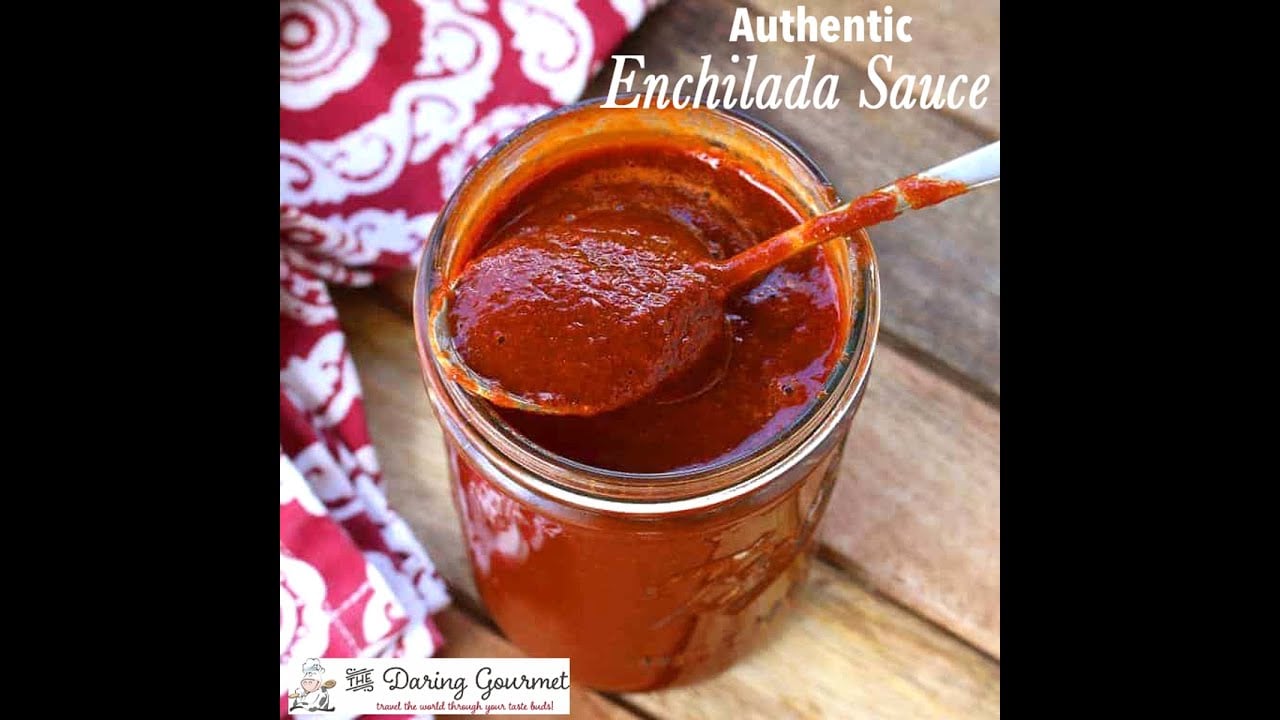


















Yay!! Yummy and easy!!
One of the BEST recipes for red sauce I have made! Been making red sauce for a long time…. did not use the chocolate, but the dark rich color and flavor that developed as it simmers is amazing! Grew up in New Mexico and Lived on the Mexican border for years… This is amazing!
Fantastic, Kay, I’m so glad you enjoyed it, thank you!
Can this be canned? I believe someone asked, but I didn’t see answer. Do you have any suggestions for substituting fresh onions due to allergies? Could you add dehydrated while simmering and then blend? Can’t wait to try.
Hi Debbie, this hasn’t been tested for canning so I cannot recommend that as safe. And yes, you can definitely use dehydrated onions instead.
This would only be able to be PRESSURE CANNED as-is. If you want to water bath can it you would need to add 1 tbsp. Vinegar (Apple cider or distilled white) or 1 tbsp lemon juice (lime would work too) to each jar before canning, depending on the size of jar you’re using. You would also need to process either method for the required time, pressure and altitude ). Please read up on how to water bath and pressure can Safely before you try this! Otherwise, just freeze it.
I made this sauce and I’m pretty user error occurred although I’m not sure where I went wrong. I made the sauce as instructed and used it for enchiladas. Unfortunately somewhere between making my sauce, prepping my enchiladas with the sauce, and taking the enchiladas out of the oven, my sauce broke. When I took the enchiladas out of the oven I immediately noticed the oil had separated, the sauce was more like a purée and at first bite it was incredibly bitter, and that was not the case before sticking it in the oven. What happened? What did I do wrong? Please help!
There was no added oil for this recipe, and we are cautioned not to use any oil for toasting. Did you mix recipes or add oil to the pan for roasting the vegetables?
Awesome Sauce! I’m replacing my family recipe with this one. My husband loved it too. I used half of the sauce on a platter of six robust beef enchiladas and tossed the rest in the freezer for next time. On the note above, Peter may be referring to the final stage of “cooking the sauce” where the recipe says to add about a “tablespoon of oil” to the pan before pouring in the puréed sauce to cook it for 30 minutes. When I cook sauces, I don’t typically oil my pan so I skipped this suggestion and just added the sauce directly to medium low heat to cook for the 30 minutes. Rich, flavorful sauce. I was happy to do without the flour rue. Chilis were a great thickening agent.
Thanks so much, Laura, I’m happy you enjoyed it!
Awesome sauce! My husband is Hispanic and doubted I could make an authentic sauce. He was even prepared to use canned enchilada sauce but I told him to give this a shot and he absolutely loved it. Every time he walked in to the kitchen he inhaled and said it smelled like homemade enchiladas! Sauce tonight enchiladas tomorrow! Thanks!
That’s awesome, Robin, I’m so glad, thank you!
Hi Kimberly….so excited to try your enchilada sauce…You mentioned in one of your comments that the sauce is not good on its own,
it needs chile sauce added. What do you mean?….. Thank you so much, Barbara jo
Hi Barbara, I just mean that it’s not meant to be eating “plain” but rather used “in” a recipe – like making enchiladas, or adding it to a stew, or in a casserole, etc.
Could this sauce be canned rather than frozen
This is almost the exact same recipe my dad always used this is my go to whenever I’m making enchiladas or pozole.